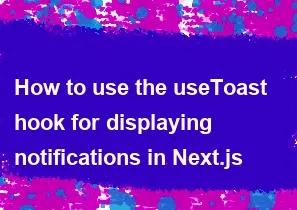How to use the useToast hook for displaying notifications in Next.js

In Next.js, you can use the react-toast-notifications library to display notifications. The useToast hook is a part of this library and makes it easy to show notifications in your Next.js application.
Here are the steps to use the useToast hook:
Install the
react-toast-notificationslibrary:Run the following command in your Next.js project to install the library:
bashnpm install react-toast-notificationsOr if you are using Yarn:
bashyarn add react-toast-notificationsImport and use the
useToasthook in your component:In your component file, import the
useToastshook from the library:jsximport { useToasts } from 'react-toast-notifications';Then, use the
useToastshook to get theaddToastfunction, which you can use to display notifications:jsximport React from 'react'; import { useToasts } from 'react-toast-notifications'; const MyComponent = () => { const { addToast } = useToasts(); const showToast = () => { addToast('Notification message', { appearance: 'success', autoDismiss: true }); }; return ( <div> <button onClick={showToast}>Show Notification</button> </div> ); }; export default MyComponent;In the example above, when the button is clicked, a success notification with the message "Notification message" will be displayed. You can customize the appearance, autoDismiss duration, and other options based on your requirements.
Customize the notification appearance:
The
appearanceprop in theaddToastfunction allows you to specify the appearance of the notification. Some common values include'success','error','warning', and'info'.jsxaddToast('Error message', { appearance: 'error', autoDismiss: true });You can customize the appearance and other options according to your application's needs.
That's it! You should now be able to use the useToast hook from the react-toast-notifications library to display notifications in your Next.js application.
-
Popular Post
- How to implement multi-language support in an Express.js application
- How to handle and optimize for changes in mobile search behavior
- How to optimize for Google's About This Result feature for local businesses
- How to handle CORS in a Node.js application
- How to configure Laravel Telescope for monitoring and profiling API requests
- How to use Vue.js with a UI framework (e.g., Vuetify, Element UI)
- How to create a command-line tool using the Commander.js library in Node.js
- How to implement code splitting in a React.js application
- How to use the AWS SDK for Node.js to interact with various AWS services
- How to use the Node.js Stream API for efficient data processing
- How to implement a cookie parser middleware in Node.js
- How to implement WebSockets for real-time communication in React
-
Latest Post
- How to implement a dynamic form with dynamic field styling based on user input in Next.js
- How to create a custom hook for handling user interactions with the browser's device motion in Next.js
- How to create a custom hook for handling user interactions with the browser's battery status in Next.js
- How to implement a dynamic form with dynamic field visibility based on user input in Next.js
- How to implement a dynamic form with real-time collaboration features in Next.js
- How to create a custom hook for handling user interactions with the browser's media devices in Next.js
- How to use the useSWRInfinite hook for paginating data with a custom loading indicator in Next.js
- How to create a custom hook for handling user interactions with the browser's network status in Next.js
- How to create a custom hook for handling user interactions with the browser's location in Next.js
- How to implement a dynamic form with multi-language support in Next.js
- How to create a custom hook for handling user interactions with the browser's ambient light sensor in Next.js
- How to use the useHover hook for creating interactive image zoom effects in Next.js